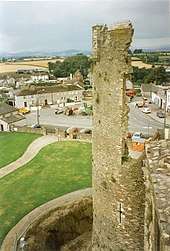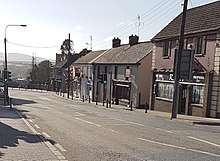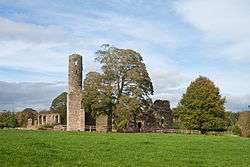Ferns, County Wexford
Ferns (Irish: Fearna, meaning "alder trees" short for Fearna Mór Maedhóg) is a historic town in north County Wexford, Ireland. It is 11.7 km (7.3 mi) from Enniscorthy, where the Gorey to Enniscorthy R772 road joins the R745, both regional roads. The remains of Ferns Castle are in the centre of the town.


Ferns Fearna | |
|---|---|
Village | |
 St. Mary’s Augustinian Abbey | |
 Ferns Location in Ireland | |
| Coordinates: 52.590°N 6.497°W | |
| Country | Ireland |
| Province | Leinster |
| County | County Wexford |
| Elevation | 60 m (200 ft) |
| Population (2016)[1] | 1,415 |
| Irish Grid Reference | T017498 |
| Historical population | ||
|---|---|---|
| Year | Pop. | ±% |
| 1831 | 571 | — |
| 1841 | 632 | +10.7% |
| 1851 | 637 | +0.8% |
| 1861 | 586 | −8.0% |
| 1871 | 568 | −3.1% |
| 1881 | 495 | −12.9% |
| 1891 | 517 | +4.4% |
| 1901 | 495 | −4.3% |
| 1911 | 505 | +2.0% |
| 1926 | 507 | +0.4% |
| 1936 | 342 | −32.5% |
| 1946 | 445 | +30.1% |
| 1951 | 441 | −0.9% |
| 1956 | 588 | +33.3% |
| 1961 | 557 | −5.3% |
| 1966 | 580 | +4.1% |
| 1971 | 712 | +22.8% |
| 1981 | 823 | +15.6% |
| 1986 | 811 | −1.5% |
| 1991 | 859 | +5.9% |
| 1996 | 915 | +6.5% |
| 2002 | 985 | +7.7% |
| 2006 | 954 | −3.1% |
| 2011 | 1,362 | +42.8% |
| 2016 | 1,415 | +3.9% |
| [2][3][4][5][6][1] | ||
History
Ferns is believed to have been established in the 6th century, when a monastery was founded in 598 dedicated to St Mogue of Clonmore (St. Aidan) who was a Bishop of Ferns.[7] The town became the capital of the Kingdom of Leinster, and also the Capital of Ireland when the kings of that southern part of the province established their seat of power there. It was a very large city then but shrunk in the fire that destroyed most of it. The city stretched all the way down and further than the River Bann (tributary of the River Slaney), if it was not burnt it would've been one of Ireland's biggest cities today. King Dermot MacMurrough founded St. Mary's Abbey as a house of Augustinian canons c. 1158 and was buried there in 1171.[8][9]
Ferns Castle, an Anglo-Norman fortress, was built in the middle of the 13th century by William, Earl Marshall. Today about half of the castle still stands. The town also contains the 13th-century St Edan's Cathedral (Church of Ireland) This was a big aisled cathedral with a long chancel. The present east wall of the cathedral is the original east wall; the cathedral ran further to the west, towards the entrance to the cemetery. It has been suggested that the ruined building to the east, which has a row of fine Gothic windows, might have been built to house the effigy of Bishop John St John, now in the porch of the church.[10] The Tower and the Chapter House were added on in the 19th century. The cemetery has several high crosses and parts of crosses.
The 19th-century population peaked in 1851, but never reached the levels of medieval times. Lewis's Topography of 1834 claimed the town "consists chiefly of one irregular street, and contains 106 houses indifferently built, retaining no trace of its ancient importance".[11] The Abbey, St.Peter's Church (Catholic and Anglican), and the remainder of the great cathedral are regarded as historic, holy places, and regarded as churches still, this includes the abbey which has the title of an abbey church.
Annalistic references
See Annals of Inisfallen (AI)
- AI741.1 Kl. Repose of Cúán.u, abbot of Ferna, and Flann.Feórna son of Colmán, king of Ciarraige Luachra, [died].
Church of St. Aidan
The old Catholic church stood at the north of the town until the 1970s, when it was decided to demolish the building. A convent, St. Aidan's Monastery of Adoration, has stood in its place since the early 1990s.
The foundation stone of the new Church of St. Aidan was laid on the Feast of St. Aidan, 31 January 1974. This new Roman Catholic church was completed in 1975. In 2007, the new church went under a major refurbishment, and during 2007 and 2008 the parish replaced the old slates with new composite metal-material. The interior was also refurbished and few minor changes were made to the look of the building.
A plaque listing the names of parish priests, from 1644, is on the wall to the right of the altar, beside the organ. The pipe organ in St. Aidan's Church dates from 1901. Its bellows were once inflated by hand, until modifications were made to it in the 1970s, one of which saw a new electric blower to inflate the bellows installed. The pipe organ was transferred from the old church to the new church and is still in use. Before being transferred, it was completely dismantled, re-shaped and re-designed to fit into a much smaller space, in the new church.
The Bell, dating from 1911, was installed in the tower of St.Mogue's Church, by Canon John Doyle. It was moved and now stands outside the new Catholic Church today, and is rung on special occasions, such as the New Year's midnight celebrations, Christmas, and Easter.
Religion and heritage
The town gave the name to the Diocese of Ferns (both Roman Catholic and Church of Ireland). The town's religious traditions live on today through the recent establishment in Ferns of a hermitage.
The whole history of modern Ireland stems from Ferns – Diarmuid MacMurrough, King of Leinster invited the Normans in 1169 to help him fight his battles (they never left) – he sealed the deal with his daughter Aoife's marriage to Strongbow.
Ferns has evidence of four distinct periods in Irish history. Archaeological digs have revealed habitations from the Bronze, Iron, early Christian and Norman eras.
Ferns boasts many ecclesiastical sites dating from early Christian era through Norman and the Middle Ages. Heritage sites include
- Ferns Castle (Visitor Centre May to end of September – 10 a.m. to 5 p.m. Open daily, housing the Ferns Tapestries)
- Cathedral graveyard
The Grave of King Dermot MacMurrough
- St. Mary’s Augustinian Abbey
- St. Edan’s Cathedral
- Remainder of the great Medieval Gothic Cathedral
- Ferns High Crosses
- St. Mogue’s Cottage
- St. Peter’s Church
- St. Mogue's Well
- Monument to Father John Murphy (who was born near Ferns)
- St.Aidan's Church (New Catholic Church)
- St. Aidan’s Monastery of Adoration (Convent on the old Catholic church site)
For further information on Ferns Heritage http://www.fernsvillage.ie/ferns-heritage-page.html
Transport
Ferns is located on the R772 road, having been bypassed by the M11 motorway linking Dublin to Wexford since 18 July 2019.
Regular (almost hourly) bus services link Ferns to Dublin and Rosslare are provided by a number of companies.
Ferns railway station opened on 16 November 1863, closed to passenger traffic on 30 March 1964 and to goods traffic on 3 November 1975, before finally closing altogether on 7 March 1977.[12]
People
- Anne Doyle - former RTÉ newsreader
- Dermot MacMurrough (d. 1171) - former King of Uí Cheinnselaig and Leinster
- Gordon D'Arcy professional Ireland and Leinster rugby player
See also
- Ferns Inquiry
- List of towns and villages in Ireland.
References
- "Sapmap Area - Settlements - Ferns". Census 2016. Central Statistics Office. April 2016. Retrieved 23 March 2020.
- "Census for post 1821 figures". Central Statistics Office Ireland. Retrieved 28 January 2010.
- "Histpop - The Online Historical Population Reports Website". Histpop.Org. 2 April 2007. Archived from the original on 7 May 2016. Retrieved 28 January 2010.
- NISRA. "Census Home Page". Northern Ireland Statistics and Research Agency. Archived from the original on 17 February 2012. Retrieved 28 January 2010.
- Lee, JJ (1981). "On the accuracy of the Pre-famine Irish censuses". In Goldstrom, J. M.; Clarkson, L. A. (eds.). Irish Population, Economy, and Society: Essays in Honour of the Late K. H. Connell. Oxford, England: Clarendon Press.
- Mokyr, Joel; O Grada, Cormac (November 1984). "New Developments in Irish Population History, 1700-1850". The Economic History Review. 37 (4): 473–488. doi:10.1111/j.1468-0289.1984.tb00344.x. hdl:10197/1406. Archived from the original on 4 December 2012.
- Blue Guide, Ireland. Brian Lalor. (p248) ISBN 0-7136-6130-5
- Gwynn, Aubrey; R. Neville Hadcock (1970). Medieval Religious Houses Ireland. London: Longman. pp. 175–176. ISBN 0-582-11229-X.
- T. O'Keeffe & R. Carey Bates, The abbey and cathedral of Ferns, 1111-1253, in Ian Doyle and Bernard Browne (eds) Medieval Wexford. Essays in memory of Billy Colfer. Dublin: Four Courts Press, 73-96
- T. O'Keeffe & R. Carey Bates, The abbey and cathedral of Ferns, 1111-1253, in Ian Doyle and Bernard Browne (eds) Medieval Wexford. Essays in memory of Billy Colfer. Dublin: Four Courts Press, 73-96
- Lewis, Samuel (1837). A Topographical Dictionary of Ireland. Dublin, Ireland: Samuel Lewis. p. 624.
- "Ferns station" (PDF). Railscot - Irish Railways. Retrieved 14 October 2007.
External links
| Wikimedia Commons has media related to Ferns, County Wexford. |
